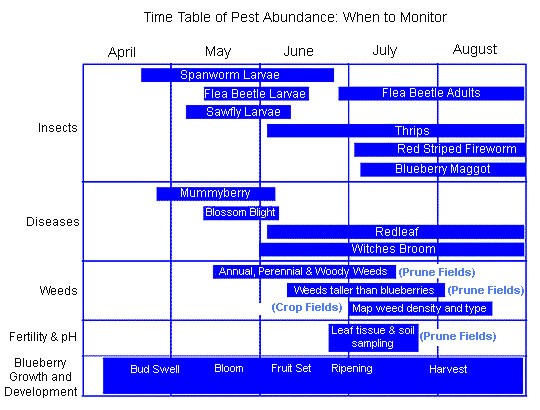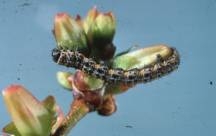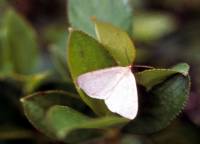197-Blueberry Spanworm (Itame argillacearia (Packard))
Fact Sheet No. 197, UMaine Extension No. 2371
Prepared by Judith A. Collins, Assistant Scientist, and H. Y. Forsythe, Jr., Professor of Entomology, in cooperation with David Yarborough, Extension Blueberry Specialist, 1995. Updated by Lily Calderwood, Extension Wild Blueberry Specialist, 2020.
Description
Young caterpillar larvae are about 1/8-inch long and dark gray to black with a series of white bands encircling the body. Fully grown larvae are about 3/4-inch long and are yellowish-orange with rows of black spots that may look like continuous black strips running the length of the body (Photo 1). Spanworm larvae often appear on plants in large numbers at night. During the day, many larvae find shelter in the litter at the base of the plants.
An easily recognizable characteristic of this larva is its “looping” walk. Pupae, which are rarely seen, are found in the litter and are dark brown or black.
- Photo 1: Larva
- Photo 2: Adult
- Photo 3: Damage
- Photo 4: Damage
Adult spanworms are delicate, light gray moths. They have a wingspan of about one-inch (Photo 2). They are especially common in weedy areas or windbreaks and will fly readily when disturbed.
Life Cycle
The blueberry spanworm spends the winter as an egg in the litter near the base of blueberry plants. Eggs may begin to hatch and larvae start feeding on developing buds as early as April and continue to feed on blueberry leaves, buds, and blossoms until late June or early July. Fully grown larvae move into the litter, where they remain as pupae. At this stage and time, they do not feed. Moths begin to emerge in about two weeks.
Adults can first be seen in the field in early to mid-June. Some moths may still be present until late July. Eggs laid by the moths do not hatch until the following spring.
Damage and Economic Importance
Infestations of blueberry spanworm may be confined to isolated areas or damage may be widespread. Large numbers of spanworm larvae may completely defoliate areas in both crop and pruned fields. Early in the season, the larvae damage the berry crop by eating flower buds and blossoms. Later larvae chew out notches on developing leaves (Photo 3). Crop fields may be dotted with areas that appear burned (Photo 4).
The first sign of a severe infestation in a pruned field is an area devoid of or with slower developing plants; look for signs of feeding on developing shoots at ground level or below the soil surface.
How to Scout for Insects Using a Sweep Net
The sampling procedure to use for most insects (spanworm, flea beetle, sawfly, etc.) involves a single sweep of a 12-inch diameter net from one side of the body to the other (180 degrees). One sample is ten sweeps. While walking through the field, keep two hands on the handle and sweep the foliage. Do not take more than one sweep for every step, and be sure the net penetrates the foliage. After taking ten sweeps, shake everything into the bottom of the net. Empty the contents into a tray, box or other container, and count the number of insects of each species. Write down the results.
Number of samples: Take at least one set of ten sweeps every 100 to 200 feet. The number of sets of 10 sweeps (samples) should be about 10 to 20 for fields of 1 to 10 acres, 20 to 30 samples for fields of greater than 10 acres and less than 50 acres, and 30 samples for fields greater than 50 acres. Include weedy and rocky areas, field edges and “dips” or “hollows” in your sample; insects are commonly found in these areas. While walking to the next sample site, look around and note anything unusual, such as malformed or brown leaves; check these areas closely. Make notes or draw a map so that areas with suspected infestations can be located at a later date. Watch for defoliated areas within crop fields or delayed emergence of blueberry stems in pruned fields. However, do not automatically assume any area with no foliage has been damaged by an insect. Look for the evidence of feeding (chewed leaves and stems) and/or the presence of insects.
I have a 15 inch sweep net. Will that change the threshold I’m looking for?
The short answer is no. You can use either a 12 inch or 15 inch sweep net that has a “muslin” or cloth bag. Newly hatched span worm is one insect that will slip through the larger holes in a mesh net. Some sweep net suppliers include Bioquip, Forestry Suppliers, and Great Lakes IPM. Dr. Frank Drummond developed thresholds based upon a 12-inch sweep net, which is what you will find on the insect factsheets. When using a 15-inch sweep net, you do take a larger swath in a 180º sweep and therefore the relative abundance of the pest will be a bit different. A 12-inch sweep net has a 36 inch arc in each sweep, which is an approximate volume of 2034 sq inches of blueberry stems. A 15 inch sweep net will sweep a volume of 2543 sq. inches. Therefore, the 15-inch sweep net captures 1.25 times the volume of the 12-inch net.
For example, if your threshold is 10 caterpillars per set of 10 sweeps with a 12-inch sweep net, your threshold with a 15-inch sweep net would be 12.5 caterpillars per 10 sweeps. This is a very small difference that can be ignored especially because the threshold 15-inch net threshold is slightly more conservative, erring toward a safer estimate of pest pressure.
Pest Management
The blueberry spanworm can be controlled with an appropriate pesticide. For additional information on monitoring and control, refer to Wild Blueberry Fact Sheets No. 209, or contact the lowbush blueberry specialist, University of Maine Cooperative Extension, 1.800-.897.0757 (toll-free in Maine) or 207.581.2923.
Information in this publication is provided purely for educational purposes. No responsibility is assumed for any problems associated with the use of products or services mentioned. No endorsement of products or companies is intended, nor is criticism of unnamed products or companies implied.
© 2020
Call 800.287.0274 (in Maine), or 207.581.3188, for information on publications and program offerings from University of Maine Cooperative Extension or visit extension.umaine.edu.
The University of Maine is an EEO/AA employer, and does not discriminate on the grounds of race, color, religion, sex, sexual orientation, transgender status, gender expression, national origin, citizenship status, age, disability, genetic information or veteran’s status in employment, education, and all other programs and activities. The following person has been designated to handle inquiries regarding non-discrimination policies: Director of Equal Opportunity, 101 Boudreau Hall, University of Maine, Orono, ME 04469-5754, 207.581.1226, TTY 711 (Maine Relay System).




